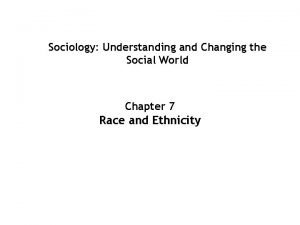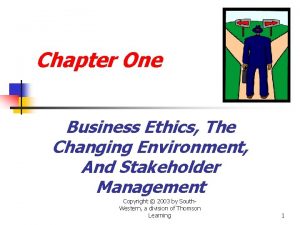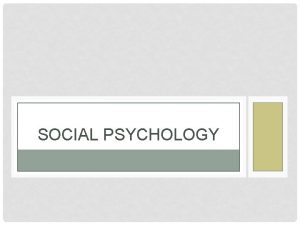3 2 Attitude formation and changing How is









- Slides: 9

3. 2 - Attitude formation and changing How is an attitude formed and how does it influence our behaviour? How can you change someone's attitude?

Attitude formation Attitudes are formed by experience and learning, influenced by a number of factors: Peer groups � Acceptance within a group can rest on sharing similar attitudes � Can help to create a sense of identity- higher degrees of cohesion Conditioning � Rewards will strengthen existing attitudes- praise for training hard Socialisation � Learnt form significant others – parents, teacher, coaches, role models and the media Familiarity � Gary Neville Rooney Citys going The more experience someone has with an object downthe more likely the attitude will be positive � Taken to sport matches at a young age

Forming a good attitude We begin to form attitudes very early in life � They continue to change, develop, form and reform all throughout life � Try to encourage young people to have a positive attitude towards participation in physical activity. � Players are strongly encouraged to developed good attitudes towards opposition and officials � Sportsmanship Why do we want positive attitudes? � Positive cognitive and affective make positive behaviour more likely � Socially valued- abiding by perceived norms � Needed to become an Elite performer � Can help coaches help to improve group dynamics (attitude to a new player)

Measuring attitude Measured in 2 ways… � Observations � Questionnaires- Using a Likert scale Issues with questionnaires… � May give the answer they think is wanted � May not fully understand the question � Understanding the Likert scale- difference between “strongly agree” and “agree” � Phrasing of statement may affect answer- negative connotation � Most attitude questionnaires aren’t specific to sport � Interpretation of analysis is largely subjective

Changing attitudes Accepting that certain positive attitudes are beneficial for elite performers… We may need to understand how to change an unwanted attitude… Persuasive Communicatio n Cognitive Dissonance

Persuasive communication Exactly as it sounds- try to influence the attitude of a performer by discussion, argument or debate. Persuade r Main factors in success of persuasive communication… � The persuader � The message Receiver Message � The receiver Persuader • • Status in the eyes of the performer Popularity- role-model status Credibility- linked to feeling of trustworthiness Social background- linked to credibility Receiver Message • • Accuracy- is it correct? Is it stated with confidence and enthusiasm? Clarity- argument well constructed? Logical? Does it appeal to intellect or emotion? Sense of duty or responsibility? • • • Are they ready for the message? - understand the arguments? How strongly held is the current attitude? Why do they hold it? Are they motivated to change? Or at least open to the possibilty?

Cognitive Dissonance Individuals like to be consistent in what they do, feel and believe… � If something new goes against this or they encounter new knowledge or feelings, they feel uncomfortable, they feel dissonance. � Motivates individuals to reduce discomfort by changing their existing attitude or acquiring new ones. So to change an attitude you can ensure that one of the three components is inconsistent with the others, thereby creating dissonance. Cognitiv e Affective Behavioural

Example of Cognitive Dissonance A group of year 10 boys are told that this term they will be doing dance but the group have a poor attitude towards it and is being uncooperative. Explaining their attitude… � Cognitive- They know dance isn’t highly thought of by their peers, maybe their dad has made comments at the TV. � Affective- Tried it before and not enjoyed it or been unsuccessful � Behavioural- Refusing to try it now (Even if they haven’t before) Changing their attitude… � Cognitive- Change their knowledge of dance, bringing in a dancer to demonstrate modern and popular dance. Show all-male dance groups and emphasise the necessary components of fitness needed (Links to Strength and Stamina) � Affective- Create a positive situation. Choose music they will like, keep difficulty at a low level to guarantee success and lots of positive reinforcement. � Behavioural- Using rewards and incentives to get them to have a go.

Evaluation Persuasive communication � Common-sense way of getting someone to adopt a more positive attitude. � Can fail in light of strongly held beliefs Cognitive dissonance � Criticised for being too simplistic � Doesn’t take into account the individual’s motivation and need for consistency Both � Are useful for understanding why a negative attitude may have formed � Are useful for giving an insight into what factors should be considered for changing an attitude However attitude change is a long process with no guarantee of
 Attitude formation
Attitude formation Formation initiale vs formation continue
Formation initiale vs formation continue Gantt chart in system analysis and design
Gantt chart in system analysis and design Systems analysis and design in a changing world
Systems analysis and design in a changing world System analysis and design in a changing world
System analysis and design in a changing world Sociology understanding and changing the social world
Sociology understanding and changing the social world Characteristics of quality culture
Characteristics of quality culture Changing decimals to fractions and vice versa
Changing decimals to fractions and vice versa Business ethics and changing environment
Business ethics and changing environment Effects of changing dimensions on surface area and volume
Effects of changing dimensions on surface area and volume

















